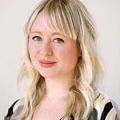EVERY year the Holocaust Education Trust (HET) takes Glasgow pupils to Poland to visit Auschwitz, the largest mass murder site in human history.
The charity aims to educate every school pupil in Britain about the horrors of World War II and the Holocaust in a bid to prevent such atrocities happening again.
Recently, a group of youngsters from Lourdes Secondary travelled on a HET trip.
Today we print their reflections from their visit to Auschwitz.
Carly Horne, 17, shared this with the Evening Times:
A large focus of the Holocaust Educational Trust, is rehumanising the events of the Holocaust. The visit wasn’t about statistics or showing us how horrific the events of the Holocaust were – we already understood that.
It was, in my experience at least, standing in Auschwitz-Birkenau and saying, “Human beings did this”. It was a very powerful experience.
It is very easy to write off the perpetrators of the Holocaust as “monsters”. This mindset was challenged when we neared Rudolf Hoess’ house.
Hoess was the commandant of Auschwitz and he lived on the grounds with his family from 1940 until he and his family fled in 1945.
Many of my group, myself included, struggled with the idea that Hoess would have brought his family to a place like this.
I was taken aback by the thought that, despite his actions, Rudolf Hoess was a family man.
While I don’t believe that this is relevant when considering his actions, it put a new light on the events of the Holocaust for me.
Men such as Hoess were viewed as “the nicest man in the world” by their families.
Yet he played a significant role in the murder of six million Jewish people. How do we comprehend these two realities?
As human beings, we have to make choices. I don’t know if every Nazi thought their actions during the Holocaust were right, but I struggled greatly with the reality that in Auschwitz, for example, S.S Officers watched and directed other human beings as they entered the gas chambers.
Many looked down the barrel of a gun and pulled the trigger knowing that they were ending another human being’s life, purely based on religion and identity; they thought this justified those actions.
I couldn’t understand how people could hold such strong prejudices.
And I can’t help but wonder how antisemitism, Islamophobia and many other prejudices continue in today’s society. We know the effects of ignorance and prejudice. We know where antisemitism and hatred can lead if we don’t stand up to it.
It’s not accurate to use the Holocaust as a blanket term for all genocide, but we can, and we should, learn from it.
As George Santayana said, ‘Those who do not remember history are condemned to repeat it’.
Kyle McAvoy, also 17, wrote this piece.
We arrived outside the infamous gate at Auschwitz.
I hadn’t watched any form of documentary or read much about Auschwitz, so I was going in to the camp with no real expectations. ‘Arbeit macht frei’, the misleading phrase that translates to “Work will set you free” hangs over your head as you pass through.
It was raining heavily, so the camp was quite dark and there was a prominent smell of damp.
Walking through the camp, there is so much to take in.
Photos of victims, as well as their belongs, which were taken upon arrival, including prayer shawls, glasses, suitcases, pots and pans, all piled high in vast rooms; it’s difficult to process it all.
Our group leader, from the Holocaust Educational Trust, and our guide from the Auschwitz-Birkenau Museum, talked us through what we were seeing.
The thing that struck me the most, and will always stay with me, was the Book of Names.
In this one book is a list of the names of those murdered by the Nazis and their collaborators.
Out of the six million Jews who were murdered, only 4.2 million could be named.
The efforts to find and document all six million names continue. All 4.2 million of the known names were in this book.
The pages are roughly 6ft tall, and the book is the length of the entire room. Its last pages remain empty for names which haven’t been found yet.
I couldn’t comprehend that, as a result of the Holocaust, these people, who once had families, friends, jobs, and whole lives ahead of them, have been reduced to names in a book.
In another room in the same block, there were numerous small drawings that had been traced onto the walls, from drawings made by children at the time of the Holocaust.
I cannot imagine what it must have been like for children in the Holocaust; they must have been so confused.
To pass time and keep them entertained they just drew what they saw. Some of the drawings included people being hung and getting on trains to be transported to Birkenau to die.
Even after participating on the Lessons from Auschwitz Project, and learning so much about the Holocaust in the process, I still find it extremely difficult to comprehend that human beings carried out such atrocities.
It is so important for people to learn about the Holocaust, as it shows what can happen if we ignore the signs of rising levels of hatred, racism and antisemitism.










Comments & Moderation
Readers’ comments: You are personally liable for the content of any comments you upload to this website, so please act responsibly. We do not pre-moderate or monitor readers’ comments appearing on our websites, but we do post-moderate in response to complaints we receive or otherwise when a potential problem comes to our attention. You can make a complaint by using the ‘report this post’ link . We may then apply our discretion under the user terms to amend or delete comments.
Post moderation is undertaken full-time 9am-6pm on weekdays, and on a part-time basis outwith those hours.
Read the rules here